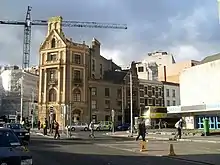Hawkins Street
Hawkins Street is a street in central Dublin, Ireland. It runs south from Rosie Hackett Bridge, at its junction with Burgh Quay, for 160 metres (170 yd) to a crossroads with Townsend Street, where it continues as College Street.
 Hawkins Street as seen from Townsend Street | |
 | |
| Native name | Sráid Hawkins (Irish) |
|---|---|
| Namesake | William Hawkins |
| Length | 160 m (520 ft) |
| Location | Dublin, Ireland |
| Postal code | D02 |
| Coordinates | 53.346231°N 6.257052°W |
| North | Burgh Quay/ Rosie Hackett Bridge |
| South | Townsend Street |
History
Hawkins Street dates from at least the early 1700s, with many of the buildings on the west side of the street having been built on former back gardens when D'Olier Street was widened as part of the Wide Streets Commission.[1] This area of Dublin had been reclaimed from banks of the River Liffey by 1673.[2] The street is named for William Hawkins (c. 1618–1680) who had been the driving force behind the reclamation, funding 450 metres of walling himself.[3][4]
Notable buildings
.jpg.webp)
There have been five Theatre Royals in Dublin's history, two of them in Hawkins Street. The third Theatre Royal was opened in the street in 1820. It burned to the ground in 1880. The fifth Theatre Royal opened in 1935. In 1962, this was demolished to make way for a large office block development, Hawkins House and the Screen Cinema.[5] Permission to demolish these buildings was granted in 2017.[6]
The rear entrance of the Dublin Gas Company building built in 1928 is also on the western side of the street. This building, designed by Charles Herbert Ashworth is in the Arts and Crafts and English Tudor styles, in stark contrast to the art deco facade on D'Olier Street.[7][8] The buildings are built to accommodate the laneway, Leinster Market.[9]
Sheahan Memorial
REF-103864.jpg.webp)
At the northern end of the street stands the Sheahan Memorial from 1906, which commemorates the place where a member of the Dublin Metropolitan Police, Constable Patrick Sheahan, died on duty. The memorial was designed by W. P. O'Neill, built by Harrison & Sons,[10] and was moved to the side of the street in 2012.[11] Its inscription reads, in English and Irish:[12][13]
This memorial was erected in memory of Patrick Sheahan a constable in the Dublin Metropolitan Police Force who lost his life in the 6th day of March 1905 in a noble and self-sacrificing effort to rescue John Fleming who had in the discharge of his duties descended the main sewer close by this spot and was overcome by sewer gas. It was also intended to commemorate the bravery of a number of other citizens who also descended the sewer to assist in rescuing the beforementioned, thereby risking their lives to save those of their fellow men
References
| Wikimedia Commons has media related to Hawkins Street, Dublin. |
Citations
- "3-4 Hawkins Street, Dublin 2, Dublin City". National Inventory of Architectural Heritage. Retrieved 5 November 2020.
- Casey 2005, p. 24.
- Dickson, David (2014). Dublin: the making of a capital city. Profile Books. p. 87.
- M'Cready, Christopher Teeling (November 23, 1892). "Dublin Street Names, Dated and Explained ..." Hodges – via Google Books.
- "All the world's a stage: An Irishman's diary on Dublin's historic theatres". www.irishtimes.com. Retrieved 1 December 2020.
- Kelly, Olivia (7 May 2020). "Hawkins House, one of Dublin's ugliest buildings, finally set to be demolished". The Irish Times. Retrieved 5 November 2020.
- "Dublin Gas Company, 10 & 10a Hawkins Street, Dublin 2, Dublin City". National Inventory of Architectural Heritage. Retrieved 5 November 2020.
- "1928 – Dublin Gas Company, D'Olier Street, Dublin". Archiseek - Irish Architecture. 17 February 2010. Retrieved 5 November 2020.
- Casey 2005, p. 418.
- Casey 2005, p. 457-458.
- "1905 – Sheehan Memorial, Burgh Quay, Dublin". Archiseek - Irish Architecture. 9 June 2010. Retrieved 5 November 2020.
- Donovan, Tom (200). "The Tragic Death of Constable Patrick Sheahan D.M.P." (PDF). The Old Limerick Journal (Winter Edition): 43-44.
- "Constable Sheahan and the escaped bull". Come Here To Me!. 11 September 2012. Retrieved 6 November 2020.
Sources
- Casey, Christine (2005). Dublin: The City Within the Grand and Royal Canals and the Circular Road with the Phoenix Park. Yale University Press. ISBN 978-0-30010-923-8.CS1 maint: ref=harv (link)